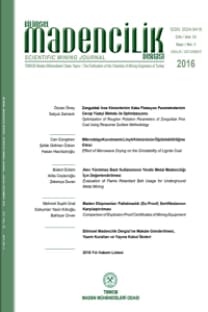ALUMİNA BİLEŞİKLERİ ESASLI ÇİMENTO ÖĞÜTME YARDIMCILARININ HAZIRLANMASI
Çimento öğütme bilyalı değirmende gerçekleştirildiğinde, öğütmenin verimliliği tanelerin elektrostatik olaylar sonucu topaklanmasıyla azalır. Bu nedenle, çeşitli öğütme yardımcıları kullanılarak aglomerasyonun önlenmesi için birçok teknik geliştirilmiştir. Bu çalışmada, mineral öğütme için, suda çözünür bir alüminat bileşiği içeren öğütme yardımcısı bileşimi ve bu öğütme yardımcısının kullanıldığı bir öğütme yöntemi açıklanmıştır. Alüminat esaslı bileşiklere dayanan öğütme yardımcıları sadece yüksek öğütme verimliliğine sahip olmakla kalmaz, aynı zamanda inorganik malzemeler oldukları için termal olarak kararlıdırlar. DEG ve TIPA gibi organik maddelere dayanan geleneksel öğütme yardımcıları ile karşılaştırıldığında, katı içerik yarıda olsa bile, öğütme verimliliği benzerdir ve bu nedenle maliyet yarıya indirilebilir.
PREPARATION OF CEMENT GRINDING AIDS BASED ON ALUMINA COMPOUNDS
When the cement grinding is performed in the ball mill, the grinding efficiency decreases due to the aggregation of the particles by the electrostatic phenomenon. Therefore, a lot of techniques for preventing agglomeration using various grinding aids have been introduced. In this study, for mineral grinding, the grinding aid composition including a water-soluble aluminate compound and the grinding method in which this grinding aid is used were described. Grinding aids based on aluminate-based compounds not only have high grinding efficiency but are also thermally stable as they are inorganic materials. Compared with the conventional grinding aids based on organic materials such as DEG and TIPA, even if the solid content is half contained, the grinding efficiency is similar and thus the cost can be reduced to half.
Keywords:
Cement Grinding aid, Alumina compound, Electrostatic,
___
- Altun, O., Benzer, H., Toprak, A., Enderle, U. 2015. Utilization of Grinding Aids in Dry Horizontal Stirred Milling. Powder Technology, 286, 610–615.
- Assaad, J.J., Issa, C.A., 2014. Effect of Clinker Grinding Aids on Flow of Cement-Based Materials. Cement and Concrete Research, 63, 1–11
- Choi, H., Lee, W., Kim, D.U., Kumar, S., Kim, S.S., Chung, H.S., Kim, J.H., Ahn, Y.C., 2010. Effect of Grinding Aids on the Grinding Energy Consumed During Grinding of Calcite in a Stirred Ball Mill. Minerals Engineering, 23, 1, 54-57.
- Ding, X.Q., Zhao, S., Ling, J., He, G., 2004. A Survey on Study and Application of Cement Grinding Aids. Materials Review, 18, 61-63.
- Gao, X., Yang, Y., Deng, H., 2011. Utilization of Beet Molasses as a Grinding Aid in Blended Cements. Construction and Building Materials, 25, 9, 3782–3789.
- Imbabi, M.S., Carrigan C., McKenna, S., 2012. Trends and Developments in Green Cement and Concrete Technology. Int. J. Sus. Built Environ, 1, 2, 194–216.
- Kucharczyk, S., Zajac, M., Deja, J., 2015. The influence of Limestone and Al2O3 Content in the Slag on the Performance of the Composite Cements. Procedia Engineering, 108, 402–409.
- Lee C. Y., Lee, H. K., Lee, K. M., 2003. Strength and Microstructural Characteristics of Chemically Activated Fly Ash Cement Systems. Cement and Concrete Research, 33, 425–431.
- Madlool, N.A., Saidur, R., Hossain, M.S., Rahim, N.A., 2011. A Critical Review on Energy Use and Savings in the Cement Industries. Renewable and Sustainable Energy Reviews, 15, 4, 2042–2060.
- Sabir, B. B., Wild S. Bai, J., 2001. Metakaolin and Calcined Clays as Pozzolans for Concrete: A Review. Cement and Concrete Composites, 23, 6, 441–454.
- Schneider, M., Romer, M., Tschudin, M., Bolio, H. 2011. Sustainable Cement Production – Present and Future. Cement and Concrete Research, 41, 642–650.
- Sverak, T.S., Baker, C.G.J., Kozdas, O., 2013. Efficiency of Grinding Stabilizers in Cement Clinker Processing. Minerals Engineering (43-44), 52–57.
- Teoreanu, I., Guslicov, G., 1999. Mechanisms and Effects of Additives from the Dihydroxy-Compound Class on Portland Cement Grinding. Cement and Concrete Research, 29, 1, 9-15.
- Toprak, N.A., Altun, O., Aydogan, N., Benzer, H., 2014. The Influences and Selection of Grinding Chemicals in Cement Grinding Circuits. Construction and Building Materials, 68, 199–205.
- ISSN: 2564-7024
- Yayın Aralığı: Yılda 4 Sayı
- Yayıncı: TMMOB Maden Mühendisleri Odası
Sayıdaki Diğer Makaleler
Mehmet SARI, Tevhit YILMAZ, Ramazan ÇOMAKLI
DİREKT ASİT LİÇİ İLE BASTNAZİT CEVHERİNDEN LANTANYUM VE SERYUM KAZANIMI
Sait KURSUNOGLU, Soner TOP, Shokrullah HUSSAİNİ, Hasan Serkan GOKCEN, Mahmut ALTİNER, Safak OZSARAC, Muammer KAYA
STANTËRG'DE “TREPÇA” MADENİNDE CEVHER VE Pb, Zn, Ag METAL ÜRETİMİNİN YILLIK PLANLAMASI
DOLOMİT İÇEREN BİR ÇİNKO CEVHERİNİN SODYUM HİDROKSİT ÇÖZELTİLERİNDEKİ ÇÖZÜNME ÖZELLİKLERİ
Cavit KUMAŞ, İlhan EHSANİ, Abdullah OBUT
ALUMİNA BİLEŞİKLERİ ESASLI ÇİMENTO ÖĞÜTME YARDIMCILARININ HAZIRLANMASI
